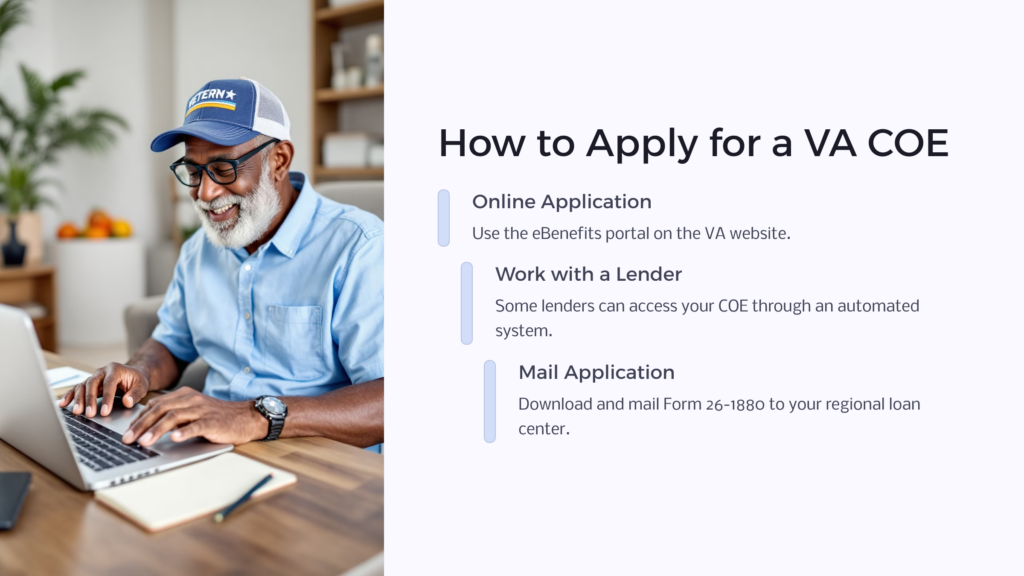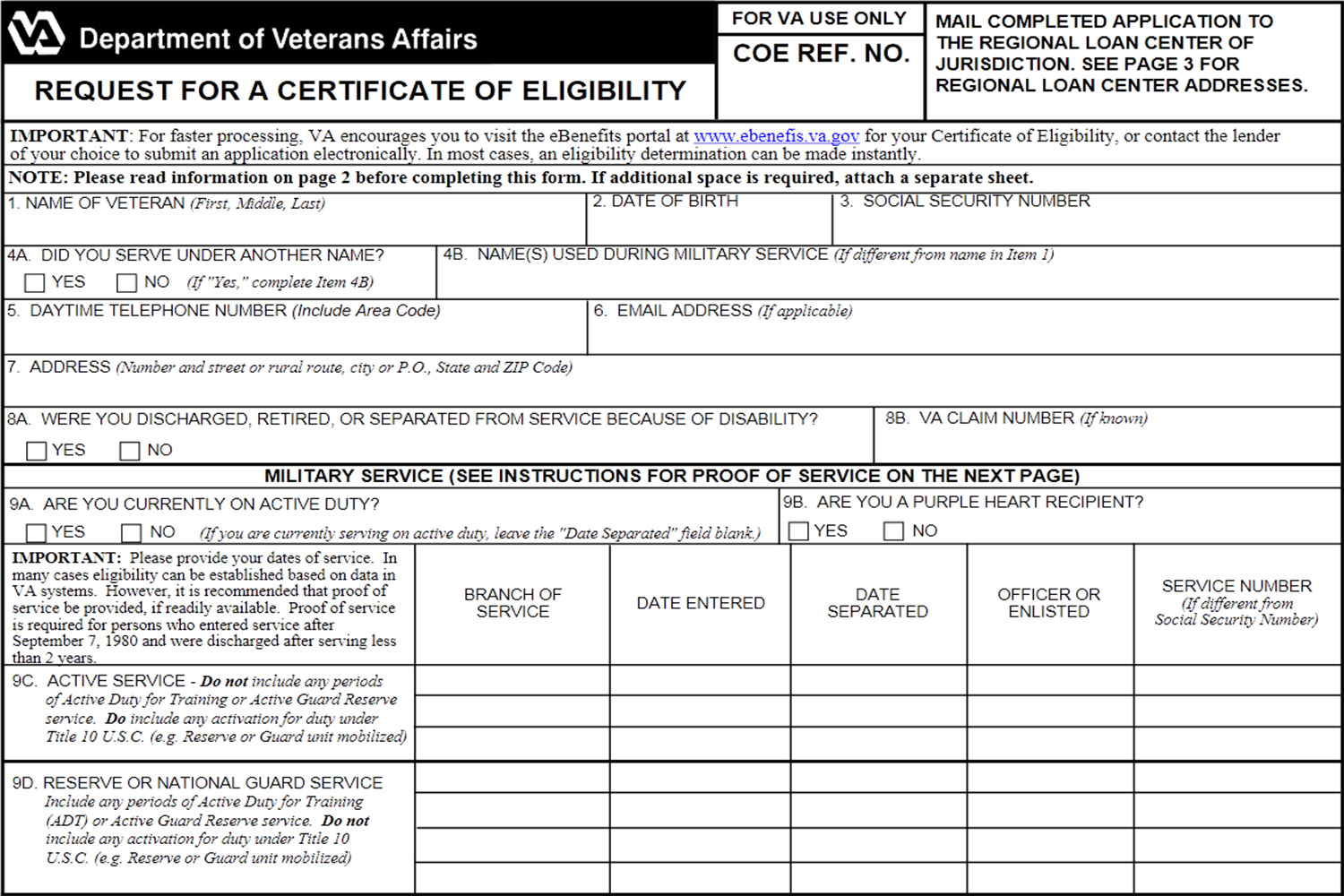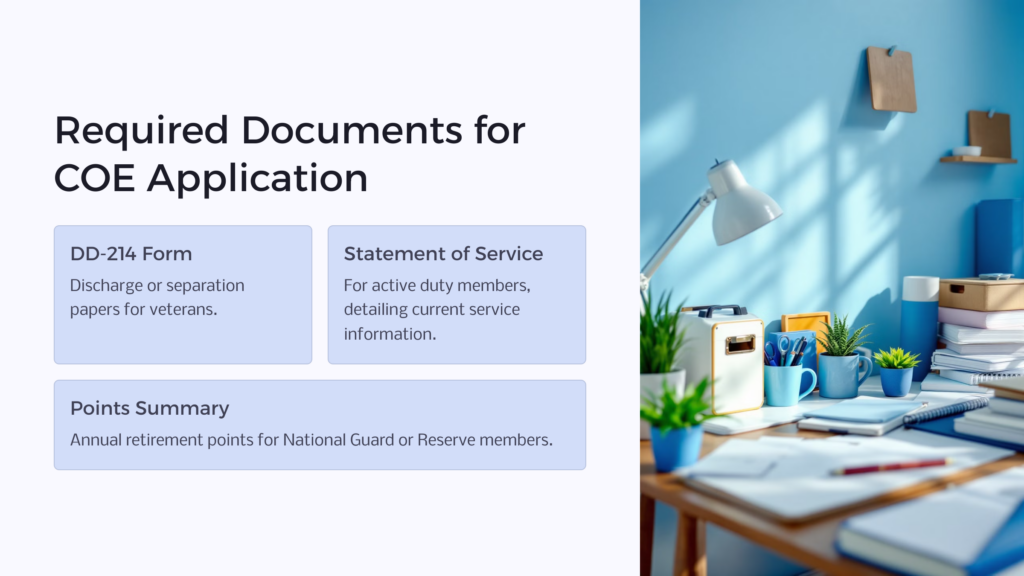If you’re thinking of taking out a home loan as a veteran, getting your VA Certificate of Eligibility could be the most important first step you take. Compared to other loan options, a VA loan can offer access to a host of additional benefits and potential advantages. For example, not only can you save money on your interest payments, but you may find you can access better terms and conditions too.

Veterans and military spouses eligible for a VA loan can purchase a home with a 0% down payment in some cases, as well as no mortgage insurance, and very flexible credit requirements. However, like many VA benefits, a VA home loan is only available to individuals with the right documentation.
Before looking for mortgage options, it might be worth checking your entitlement and ensuring you can acquire a certificate of eligibility. After all, any lender will need to see your COE before they can sign off on giving you a unique deal.
What is a VA Certificate of Eligibility (COE)?
Let’s start with the basics: What is a VA Certificate of Eligibility?
A VA COE or Certificate of Eligibility is issued by the US Department of Veterans Affairs. It tells lenders whether you’re an active duty service member, veteran, or military spouse, entitled to specialist home loan deals. Getting your CEO is the first step in qualifying for a VA loan because a lender cannot approve a VA home loan (or mortgage) without it.
It is possible to start applying for mortgages before you receive your COE in some cases. Before closing the deal, you’ll just need to ensure your mortgage provider has the enrollment certification. However, any questions about your military status or unexpected delays with your VA certification could turn your home-buying process on its head. It’s worth keeping this in mind if you’re concerned about a difficult loan process.
Aside from showing you’re eligible for a VA loan, a COE also tells lenders exactly what you’re entitled to. The benefits you can access as a service member will usually depend on the length of your military service. There are types of entitlement codes that can be added to your COE:
-
No entitlement: If the COE says you have no entitlement, it means you’re currently not in a position to apply for a VA home loan. This usually happens if you’ve already used a VA home loan certificate to purchase a property and you still owe something on this mortgage. You’ll need to pay back the money you owe before applying again.
-
Partial entitlement: If your COE indicates a “partial entitlement” to VA benefits, this could mean you can only access limited support from your VA approved lender. Usually, this is the case when you already have a VA loan you need to finish paying off.
-
Full entitlement: If you have full entitlement to VA benefits, you can purchase a home with a 0% deposit. As of 2020, VA borrowers with full benefits entitlement are not subject to any loan limits.
Notably, the length of service required to determine your COE eligibility will depend on several factors, including when you served, and why you were discharged or left the military. For instance, if you were discharged from military service early as a result of an injury, the requirement for a minimum service length can sometimes be waived.
Why are VA Certificates of Eligibility Important?
Knowing how to request your certificate of eligibility is crucial if you want to save money on your home loan. Working as a member of the military, the army national guard, or as another service member makes you eligible for certain levels of support and unique VA benefits.
Depending on your situation, you may be eligible for tuition assistance or an education benefit if you want to return to school and expand your skills. The Department of Veterans Affairs can also offer a range of unique payment benefits to veterans needing financial aid due to a disability.
VA loan benefits are just one of the ways the United States government attempts to give something back to its veterans, military spouses, and active service members. With a Certificate of Eligibility, you can prove to lenders that you have officially met the requirements set by the VA for military service. In turn, you’ll be able to access benefits like:
-
No guideline minimum credit score requirements when applying for loans
-
No requirement for mortgage insurance
-
A down payment of 0% when buying a home
VA loans don’t have any income restrictions and cap lender fees at a maximum of 1% of the total loan amount. This means you could significantly reduce your spending on buying a house over the years. Additionally, there are sometimes extra benefits available for people in specific situations. For instance, veterans with qualifying disabilities from active duty service can apply for exemption from VA loan funding fees and exemption from property taxes.
You may even be able to use your COE to check your eligibility for various disability housing grant programs, such as the “Specially Adapted Housing” initiative. Check your VA disability rates and options on the VA website for more information.
How to Read a VA COE
Personal Information
After receiving your COE, you will be able to look over the information it contains, and be able to better understand your potential home loan benefits. Personal information about you appears on the form, including your name, service number, Social Security number, and the military branch under which you served. This information is usually very direct and easily identifiable.
Entitlement Codes
The next item you may notice on your Certificate of Eligibility is an Entitlement Code. This is a number that confirms your military service, and particularly references an official era of service. The codes are numbered 1 through 11, and include the following references:
01 – World War II
02 – Korean War
03 – Post-Korean
04 – Vietnam War
05 – Entitlement Restored
06 – Surviving Spouse
07 – Spouse of POW/MIA
08 – Post World War II
09 – Post-Vietnam
10 – Gulf War
11 – Selected Reserves
The minimum service requirements to qualify for a VA home loan are different based on the era in which you served. Once you have seen your entitlement code, you can go to the U.S. Department of Veterans Affairs (VA) website, and look at the minimum requirements based on the era specified by your entitlement code.
Entitlement Code 05 (Entitlement Restored), refers specifically to those who have previously taken out a VA loan and repaid the loan. In other words, their loan has been restored. This code may specify greater funding fees or have other implications. Having had a previously restored VA loan may limit your options in taking out another one. In some circumstances, a borrower may fully restore their entitlement, while still in the possession of the property that was purchased with the first VA loan.
In other circumstances, the borrower may be required to dispose of (sell) any properties formerly purchased with a VA home loan before being eligible to take out a new VA home loan. Read each piece of your COE, and discuss your entitlement code with your lender.
Funding Fees
The next item found on the Certificate of Eligibility is the VA Funding Fee. The funding fee is a one-time closing cost fee that is paid to the VA (U.S. Department of Veterans Affairs). Monies received from the funding fees help pay for the VA home loan program (for example, paying for loans that have defaulted).
This field may display one of three possibilities: “exempt,” “non-exempt,” or “contact RLC.” If the field displays “exempt,” the borrower does not have to pay a funding fee. “Non-exempt” means that the borrower will need to pay a funding fee. If the field displays “contact RLC,” it means that the automatic system that generates COEs is not able to make the determination, and more information is necessary. In this case, a borrower should discuss this response with the lender. The lender will need to contact the U.S. Department of Veterans Affairs to provide additional information necessary to make the exemption determination.
Entitlement Amount
The entitlement amount section is perhaps the most confusing section of a VA Certificate of Eligibility. The COE will list a “basic entitlement amount,” and will then state that most loans involve additional entitlement. The current “basic entitlement amount” for full entitlement is $36,000. That number is not the loan amount. It simply informs the lender that you have full entitlement and guarantees them that the VA will pay $36,000 (for loans under $144,000) or 25% (for loans over $144,000) in the case that you default on your loan. To understand your entitlement amount, you should look up the current VA home loan limit on the VA website. If you have full entitlement, your entitlement amount is 25% of the loan limit.
Depending on your specific situation (for example, if you have a previous VA home loan that you fully paid off, or if you have a current VA home loan that has not been paid off or has not been restored), specific conditions may be applied to your entitlement for your VA loan, and these conditions can be found on your Certificate of Eligibility.
Conditions
Some conditions may limit your entitlement or specify bonus entitlement, and will be explained in the middle of the form. Entitlement codes, funding fees, and entitlement amount, your specific situation, military service history, and VA loan history will determine whether you have additional conditions that apply to your VA loan eligibility.
Listed conditions may also involve additional required steps and forms. Some common examples of situations that may apply conditions on your VA Certificate of Eligibility include:
- Having a previous VA loan that has been paid off but you still own the property
- Having a currently active VA loan that has not been fully paid off
- Having a foreclosure, short sale, or bank title transfer on a former VA loan that was not paid in full
- Currently receiving service-related disability benefits or education benefits
- A change in the borrower’s current status of active duty
Understanding the conditions listed on your COE will help to clarify your specific VA home loan eligibility and illuminate any additional steps to be taken. The lender should closely review all of the listed conditions and follow all of the necessary additional steps. The VA publishes informative pamphlets and circulars, and articles on their website, that specify the details of potential conditions.
How to apply for a VA Certificate of Eligibility?

The good news for veterans is applying for a Certificate of Eligibility is rarely as complex as it seems. Before starting the VA loan process, however, it’s worth making sure you know all your options for home loans. While VA loans can offer many benefits, including lower mortgage rates, they sometimes come with funding fees, making them more expensive.

Check whether your disability benefits allow you to waive the VA funding fee using the VA website. If you only have basic eligibility for VA home loans and you can’t access any disability benefits, compare all of your housing loan options before sending in your VA form.
Once you’ve decided you officially want to apply for a VA loan, you can request a copy of your certificate of eligibility in one of three ways:
1. Request your certificate online
One of the easiest ways to get information about any VA benefit you can access, and apply for the right documentation, is to log into the eBenefits portal on the VA website. You should be able to log into your account with an ID.me login, Premium DS login, or LOGIN.GOV account.
If you don’t have any of these login details, you can sign up with the provider of your choice by visiting the Access VA page from your preferred platform. Once you’re logged in, visit the “Welcome” page, and click on “Manage your Benefits.”
2. Work with a Lender
You can speak to your lender if you’d prefer to access a little more help when applying for your VA COE. In some cases, a VA loan provider will be able to access a portal known as the Automated Certificate of Eligibility online system. They can submit a request for a copy of your certificate and entitlement statement and usually get results in a very short space of time.
Keep in mind while some lenders will be able to help you with your VA form, not all loan cases will be able to be processed this way. If the Veterans Affairs group doesn’t have enough information in your file, they won’t be able to issue an entitlement COE instantly. This could mean you need to get in touch with the VA and provide additional data.
3. Request a certificate by mail
Another way to request your VA certificate of eligibility is by mail. Notably, this method can mean it takes a little longer to receive a response, depending on the postal service in your area. To request your certificate by mail, you’ll need to download a copy of the VA form 26-1880. You can usually get this from the VA loan certificate website or your lender.
Keep in mind to successfully fill out this form, you’ll need information on the dates of your active military service. You’ll also need to provide insights into any prior VA loans you might have taken out. Once you’ve answered all the questions on the form, send it to your regional loan center. You can find the address on the last page of Form 26-1880 package.
What documents are required for a VA COE application?

Whether you’re applying for CEO to access a VA educational benefit or a VA home loan, you will be expected to provide certain pieces of information. Often, for veterans, the easiest way to access a certificate of eligibility is to ask a lender to pull information directly from the government’s automated database, so they can avoid having to gather all of the right documentation manually.
If you choose this route, you may be able to acquire your eligibility certificate with nothing but your social security number and birth date. However, depending on the nature of your service, other documents may be required to accompany your VA form. For instance, you may need to submit a DD-214 form detailing your discharge from active duty.
The documentation you provide may also vary depending on your current status.
Active Military Member:
If you’re still serving in active duty, you may need to submit a current statement of service approved by a VA certifying official. This document will usually highlight your full name, social security number, and date of birth, alongside other key details like your:
-
Service branch
-
Rank< p>
-
Unit of assignment
-
Current duty location
-
Last discharge (and the type of discharge)
-
Commander’s name
While there isn’t a standard one-size-fits-all format for a statement of service, most VA lenders will accept a document with all of the information above, printed on official military letterhead.
National Guard Member:
Members of the National Guard or those serving as a member of the reserves will not have a single discharge certificate similar to the DD-214 for veterans. This means they will instead need to submit their latest annual retirement points summary, alongside evidence of their service.
A member of the army or air national guard could submit an NGB form 22 or an NGB Form 23 statement. Members of the reserves or National Guard may also need to provide a statement of service that includes all of the information required from the document for active military members above.
Surviving Military Spouse
The surviving spouses of military members can also request a Certificate of Eligibility for a VA Loan. However, you will only be able to apply for this certificate after you have successfully begun receiving Dependency and Indemnity Compensation benefits. This will require you to fill out the VA Form 21P-534EZ, found on the VA website.
If you are receiving these benefits already, you can complete a request for the Determination of Loan Guaranty Eligibility form, known as VA Form 26-1817. In addition, you will need a copy of the veteran’s DD-214 to complete your application or some other acceptable papers showcasing their active duty. In some cases, loan providers may also request the death certificate of your military spouse.
How to check the status of a VA Certificate of Eligibility application?
When you’re trying to get a home loan, it’s fair to say you’ll want things to move as quickly as possible. Unfortunately, it’s difficult to know for certain exactly how long you’ll need to wait for a Certificate of Eligibility to be delivered. It can take up to 6 weeks for your COE form to arrive, even if no further information or documentation is required from you.
Applying for your VA certificate of eligibility through the post can take even longer, particularly if you are required to send additional information at a later date. This is why most lenders recommend asking your lender to request your COE on your behalf. If a lender uses the automation system online to check your entitlement, you can walk away with your certificate the same day.
If you request your COE Online, through the eBenefits portal, or via a lender using a Web LGY platform, you can also track the progress of your request more easily. For example, suppose you discover, after an application, that the VA doesn’t have enough information on file. In that case, you can log into your eBenefits account to track the progress of your request after you send the appropriate documentation.
You’ll also be able to use your online account to keep track of other VA entitlement options, such as educational assistance benefits or disabled veterans benefits.
What happens if my VA Certificate of Eligibility application is denied?
Military service doesn’t necessarily guarantee that your request for a COE will be automatically approved. There are a few reasons why your VA COE request may be denied, such as:
-
Discharge: To be eligible for a VA COE, you must have served at least 90 consecutive days in the armed forces during wartime. You will also need to have had an “honorable discharge.” If you were discharged for dishonorable reasons, you would not be eligible for either a VA COE or a VA loan.
-
Length of service: Eligibility for VA loans is determined based on how long you serve in the military. You will need to serve at least 90 consecutive days to be eligible in wartime. During peacetime, this minimum increases to 181 days. However, if you leave the military before you reach the minimum cap because of a service-connected disability, you may still be eligible for a loan from a VA lender.
-
Surviving spouse issues: If you’re the surviving spouse of a veteran, you will only be eligible for a COE if you did not remarry and if one of the following conditions are met. You’ll need to prove either:
-
Your spouse died due to a service-linked disability or injury
-
Your spouse was a POW or went MIA for at least 90 days
-
Your spouse was continuously disabled and eligible for VA disability benefits
If you were denied a COE and believe you should be eligible for VA loan support, you can file an appeal with a written “Notice of Disagreement” to the Bureau of Veterans Affairs. There are a few different ways to appeal. For example, you can request for the VA board of appeals to consider your case, or ask for a higher-level review of your situation from a different officer.
Alternatively, if you believe you have additional information you can provide which will demonstrate your VA loan eligibility, you can submit this as supplemental evidence.
How to use a VA Certificate of Eligibility to purchase a home?

Once you’ve acquired your VA Certificate of Eligibility, you can start applying for home loans and other forms of financial support in some cases. However, it is worth noting that a COE won’t necessarily guarantee you’ll be approved for a VA home loan. It’s very rare for a loan provider to reject a loan application from someone with a COE form. However, it can happen.
If you’re not approved for your loan, you can always ask for the reason behind the rejection and consider taking your COE to another lender to try again. As long as you haven’t used up your eligibility already, nothing is stopping you from looking into another loan.
Here’s how you can apply to purchase a home with a VA loan using your COE:
-
Step 1: Show your COE to your lender: You’ll need to show your Certificate of Eligibility to your lender or provide them with a copy of your COE to prove you qualify for the full VA home loan benefit and a 0% deposit on your new property. Your lender can usually request a copy of your certificate of eligibility themselves if you don’t have an extra.
-
Step 2: Create a budget: Once you’re approved for a VA home loan benefit, create a budget for your new property. Look at your current credit profile, income, and expenses to ensure you know how much you can spend on a new home. It’s worth taking any funding fee expenses you may need to pay into account when budgeting too.
-
Step 3: Choose a real estate agent: With a good idea of your entitlement options and your available budget, select a real estate agent to help you. Look for a reputable professional in your local area, and consider meeting face-to-face. Having a conversation with a real estate professional before you dive into the purchasing process can help to put you at ease.
-
Step 4: Shop for a home: Ask your real estate company to show you houses that adhere to your specific price range and needs. It’s worth writing a list of the factors you’re most concerned about when choosing a home. For instance, you might want to make sure your home is located in a quiet area, or that it has plenty of access to public transportation.
-
Step 5: Create and sign a purchase agreement: Once you’ve chosen a home you like, work with your agent to create a purchase agreement. The sales contract should include the “VA escape clause”. This basically means the contract can be made void if the property hasn’t been appraised for the contract price. You can also ask your real estate expert for other strategies you can use to protect yourself from additional, unexpected expenses.
-
Step 6: Have the house inspected: Next, have the house inspected and appraised by a professional team. A VA-approved appraiser will be able to check all of the components of the house to make sure it meets basic property condition requirements. They can also provide an opinion on the overall value of the house. If the property doesn’t appraise at the right value, you can request a reconsideration of value, renegotiate the sales price, or leverage your VA escape clause.
-
Step 7: Review and close: Once you’re happy with everything, review the pre-closing paperwork for your new home and ensure your lender has any other information they might need. Most lenders will provide a closing disclosure at least three days before the deal is completed. Make sure you read it carefully and check all of your loan terms, fees, closing costs, and estimated monthly mortgage payments. You can then sign all of the correct documents to officially acquire your new house. After that, all that’s left to do is move in!
VA COE FAQs
Do you need to renew a certificate of eligibility?
While a VA COE doesn’t “expire,” it may need to be updated and renewed from time to time. For instance, if you received your COE during a period of active duty, you may need to get it updated after you’re honorably discharged from service.
What’s the maximum entitlement for a VA certificate of eligibility?
The maximum entitlement for a VA COE is simply “full entitlement.” This basically means you can access all of the benefits afforded to people who are eligible for VA home loans.
Can a VA Certificate of Eligibility be used more than once?
Technically, it is possible to use a VA COE more than once. If you have paid off the prior VA loan you acquired, and exited the property, you can have your eligibility restored to purchase your next home. In rare cases, it may even be possible to have your eligibility restored if you have paid your previous loan in full and you haven’t left or gotten rid of the property.
Can you have two VA loans at once?
It is potentially possible to have two VA loans at once, provided both homes are purchased as primary residences. This could be the case for active service members who purchase a home with a VA loan before transferring to another city. In this case, you may need to move into a new city before you have an opportunity to sell your current home.
What does a certificate of eligibility look like?
A certificate of eligibility is a relatively simple document that displays some basic information. It will typically include your VA reference number, your name (or the veteran’s name), and the last four digits of your social security number. The COE will usually also include details about your entitlement (or an entitlement code) and your branch of service.
Does a VA COE Guarantee I’ll Get a VA Loan?
Unfortunately, a VA Certificate of Eligibility won’t guarantee that you’ll get a VA loan. No one is guaranteed one of these loans. Rather, a COE ensures you can successfully apply for a loan. It is still up to the loan provider to determine whether you should be given the loan. This means you’ll still need to measure up to the criteria set by the lender. However, it is rare to be denied a VA home loan if you have a COE.
 Benefits.com Advisors
Benefits.com Advisors
With expertise spanning local, state, and federal benefit programs, our team is dedicated to guiding individuals towards the perfect program tailored to their unique circumstances.
Rise to the top with Peak Benefits!
Join our Peak Benefits Newsletter for the latest news, resources, and offers on all things government benefits.





















